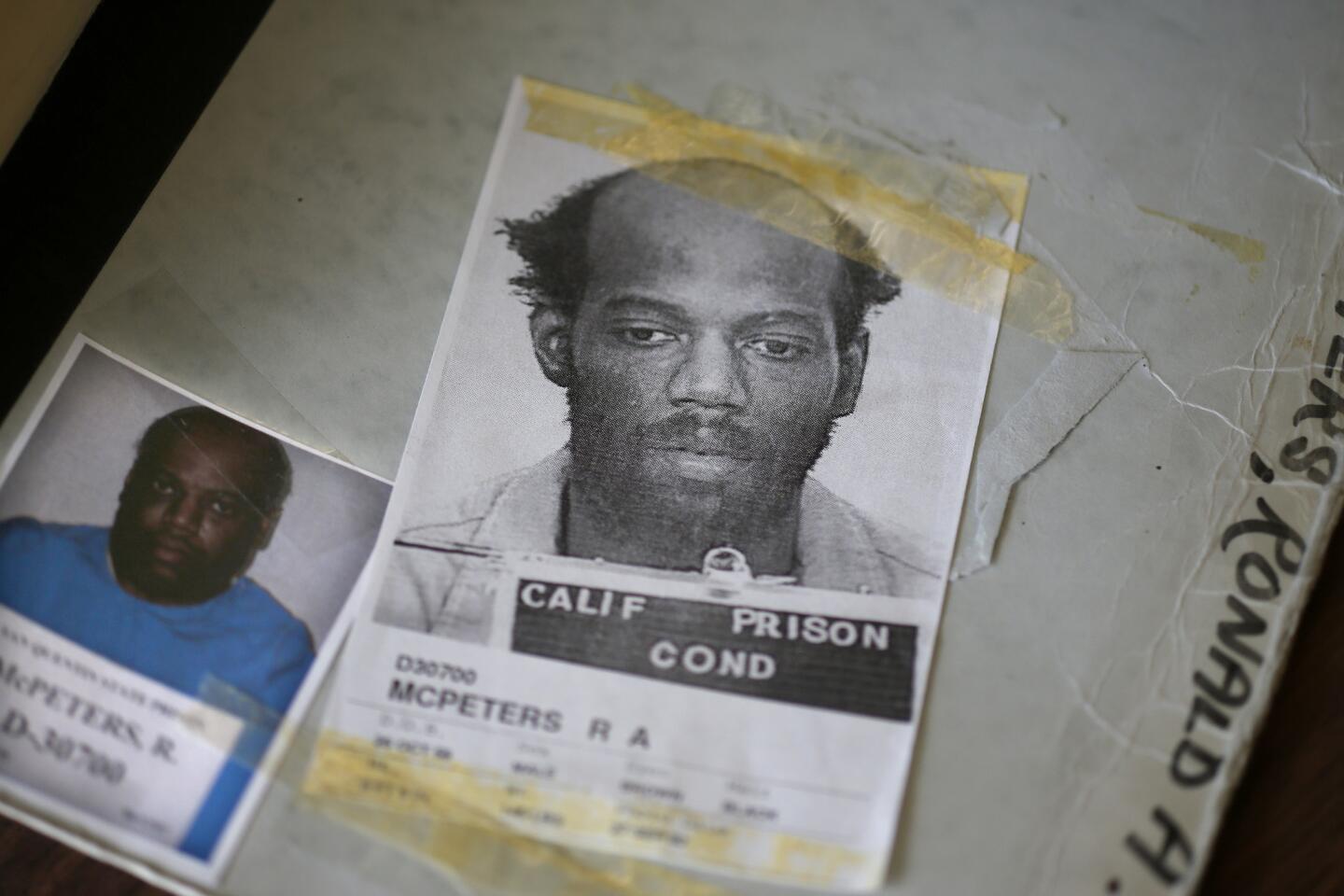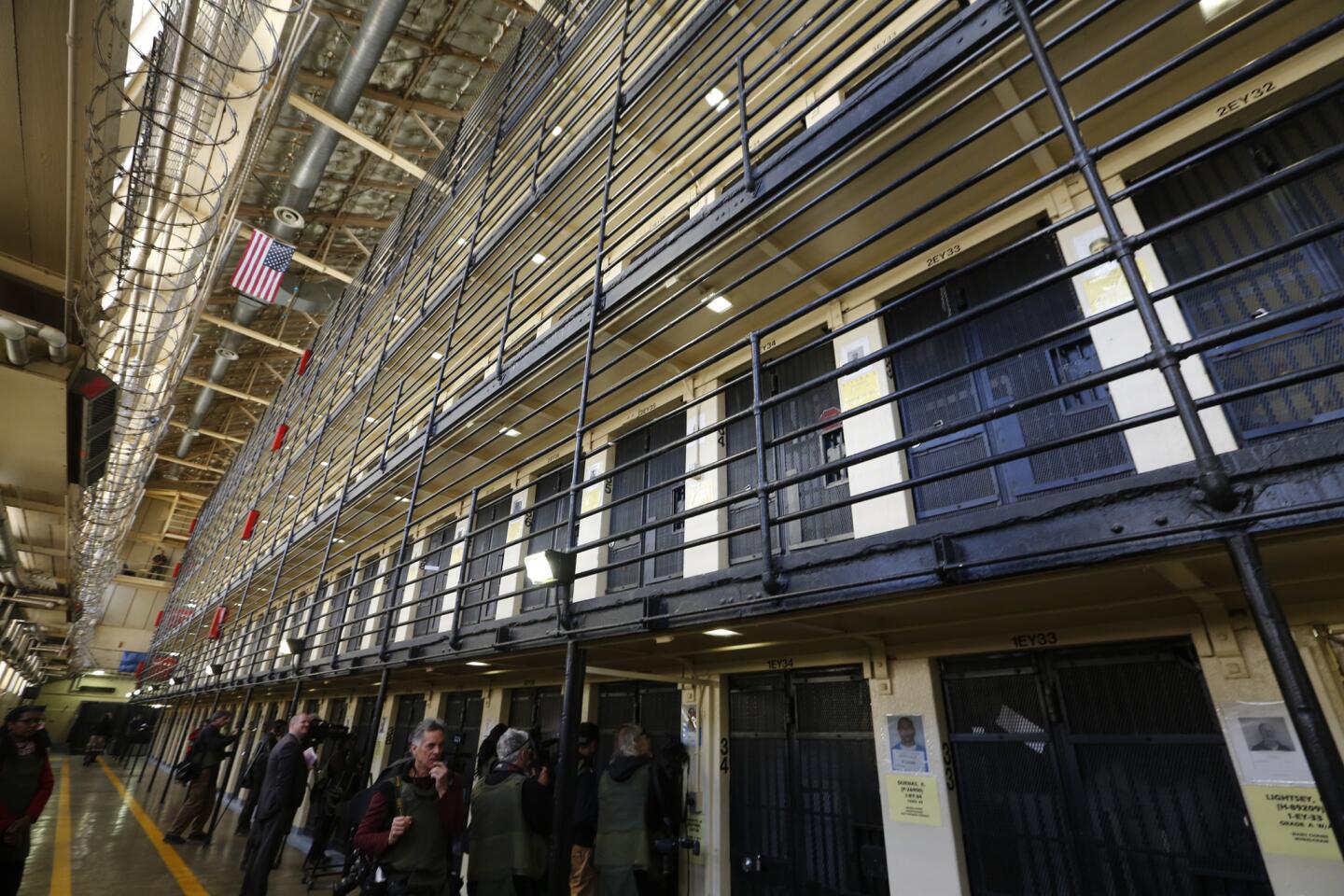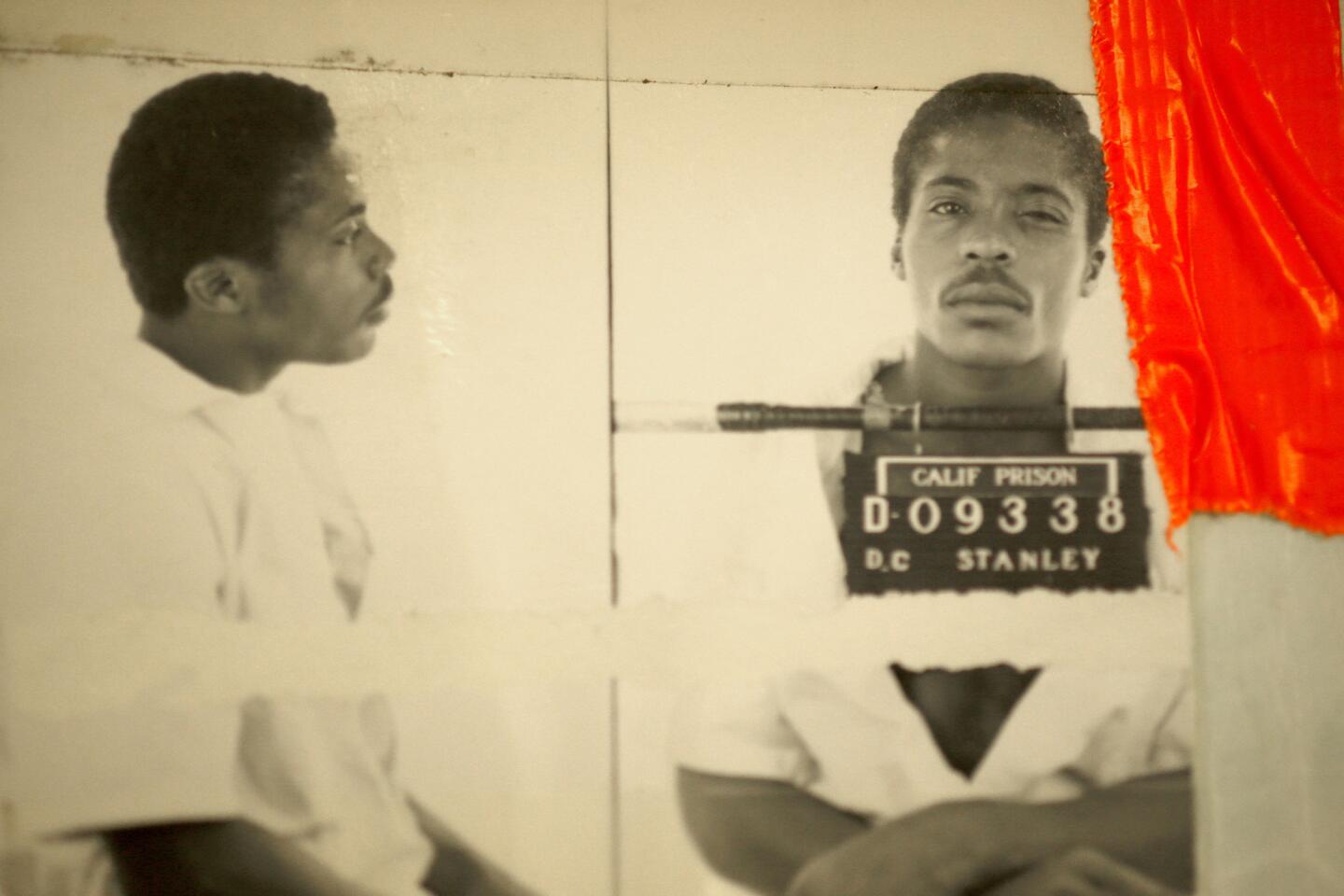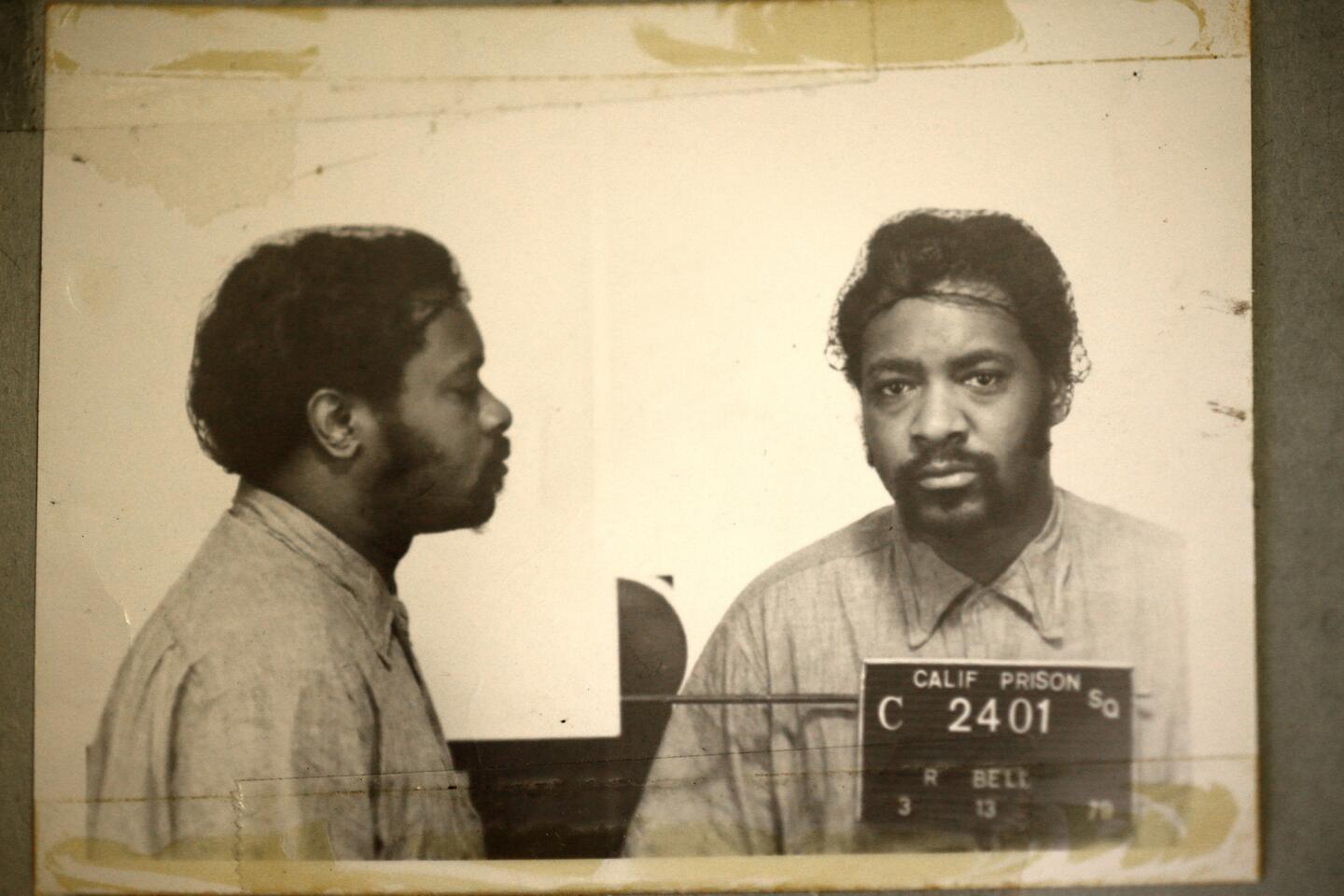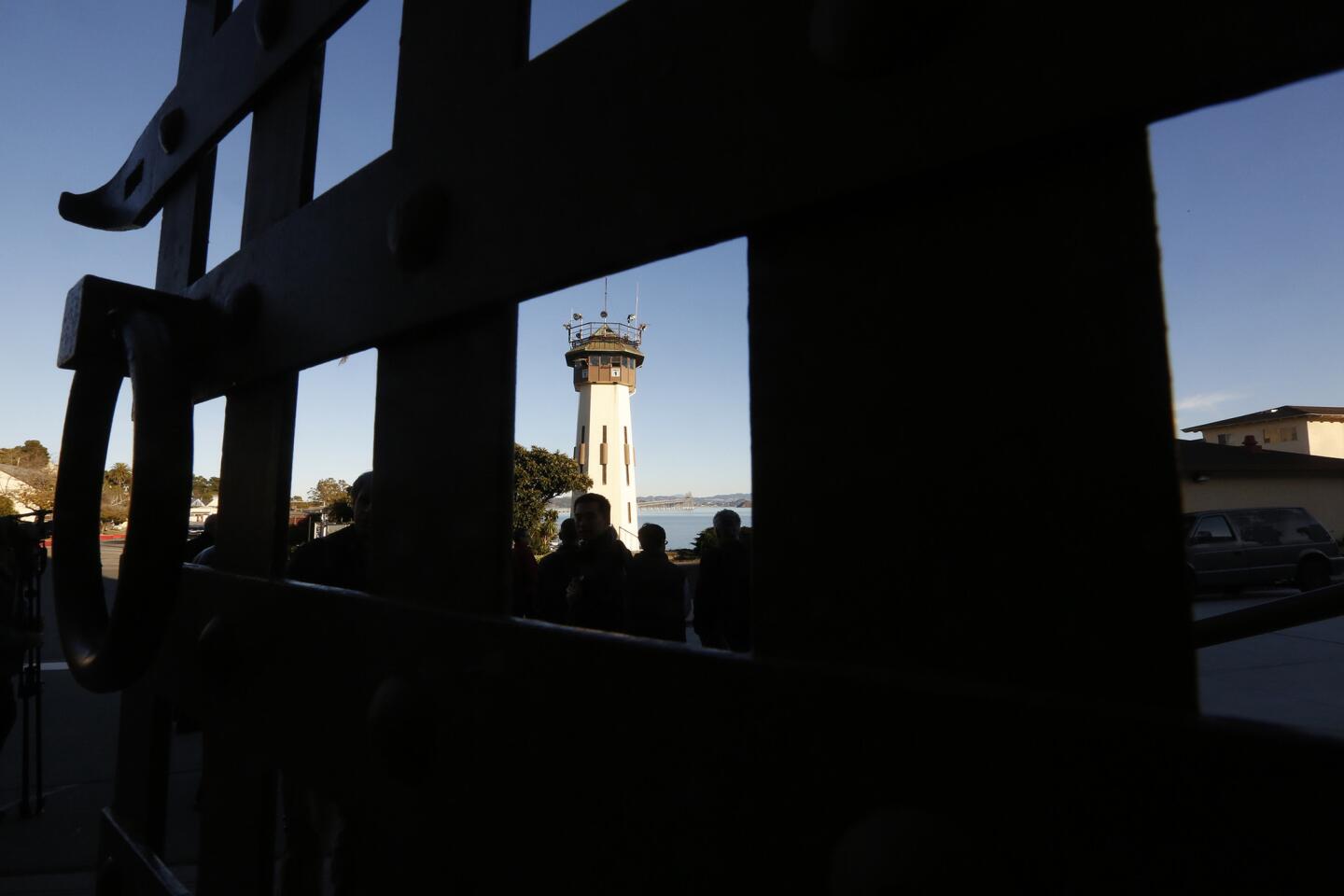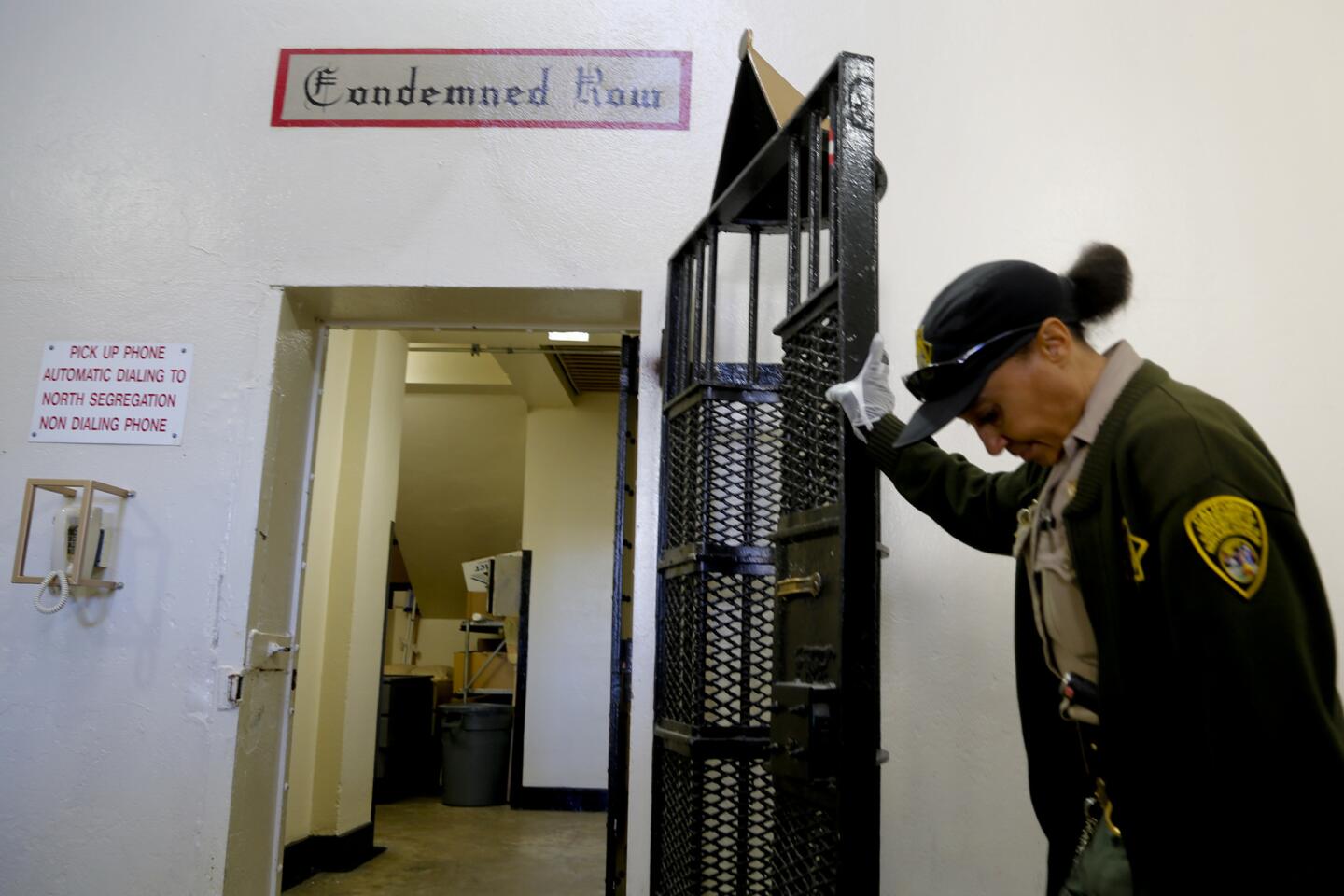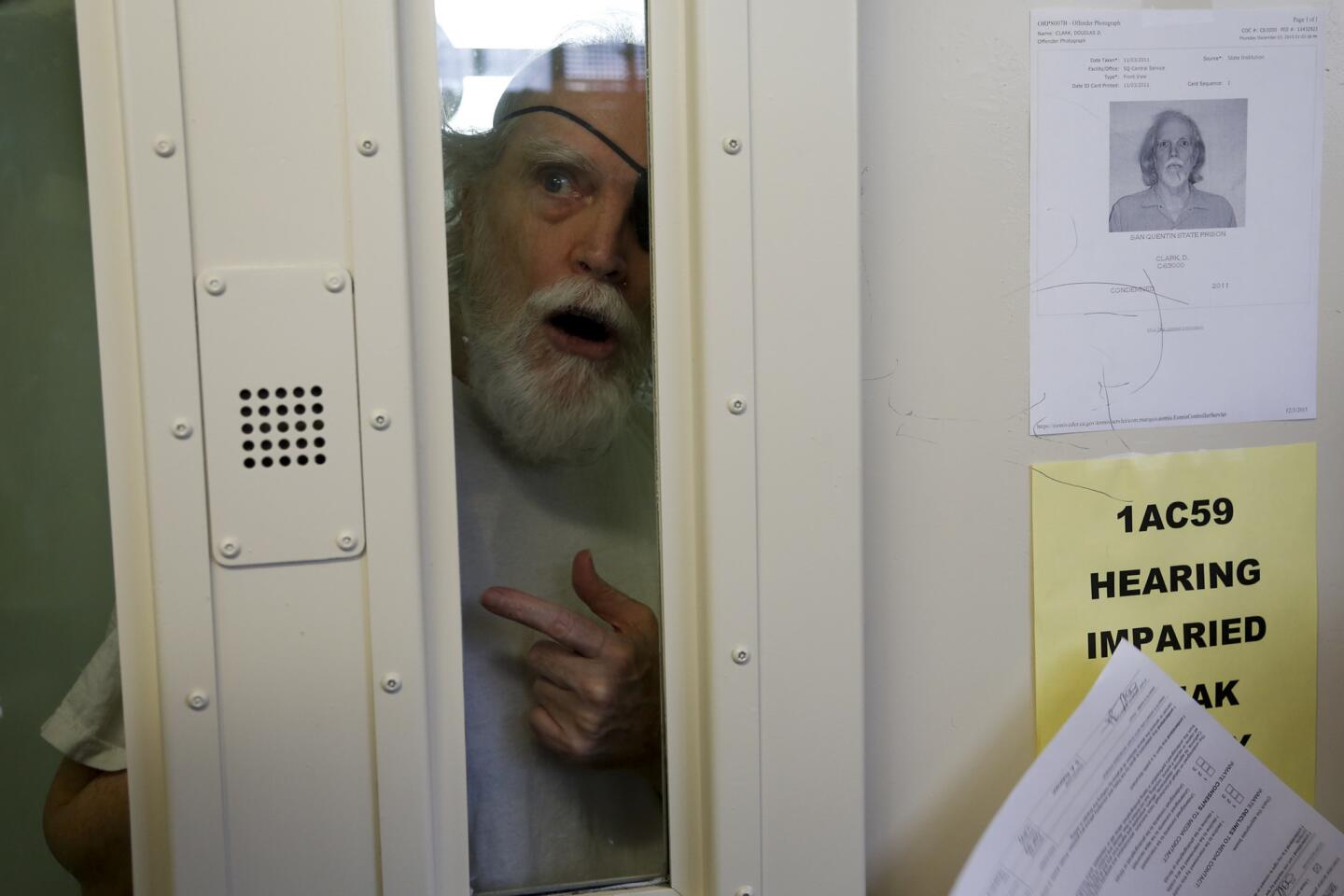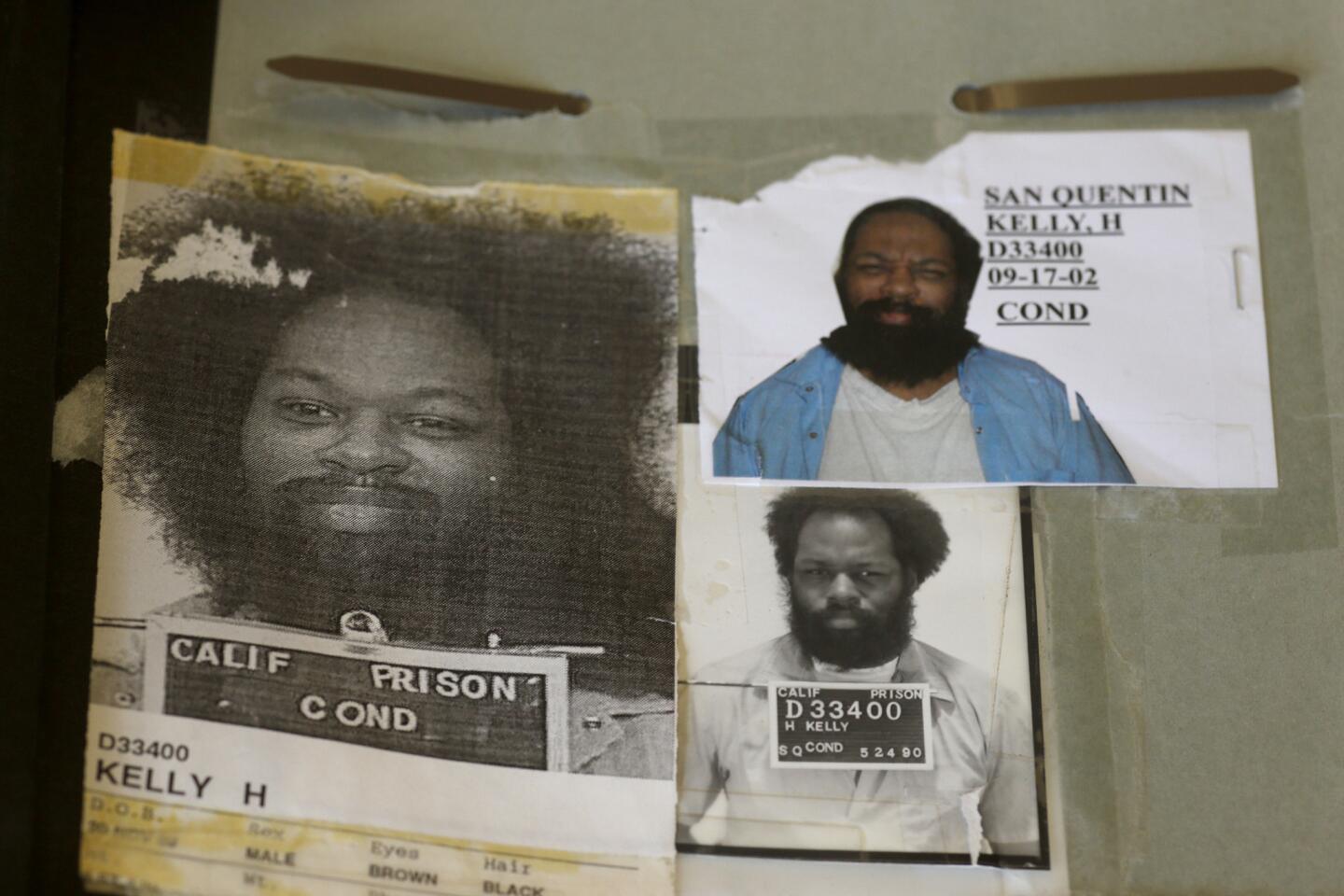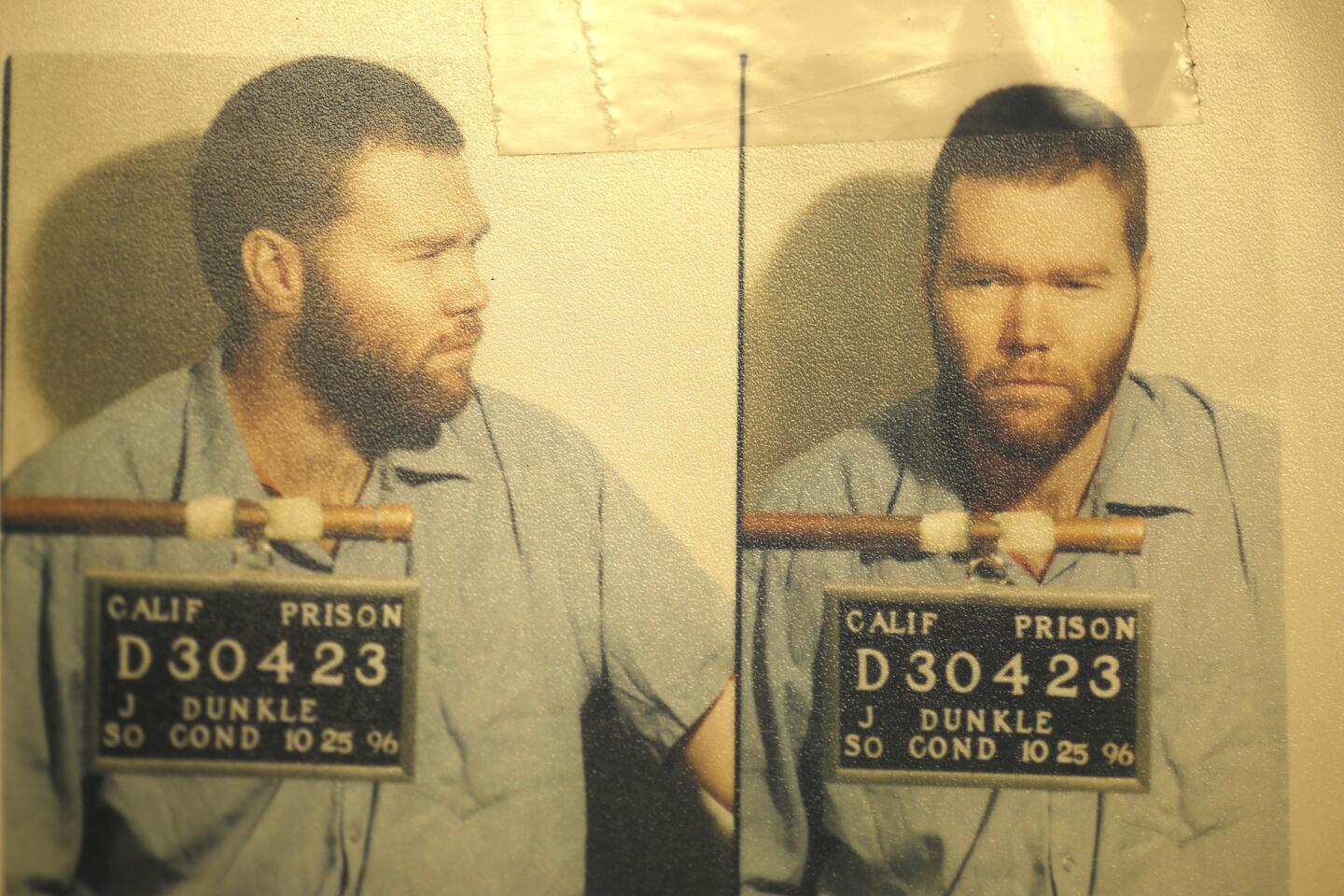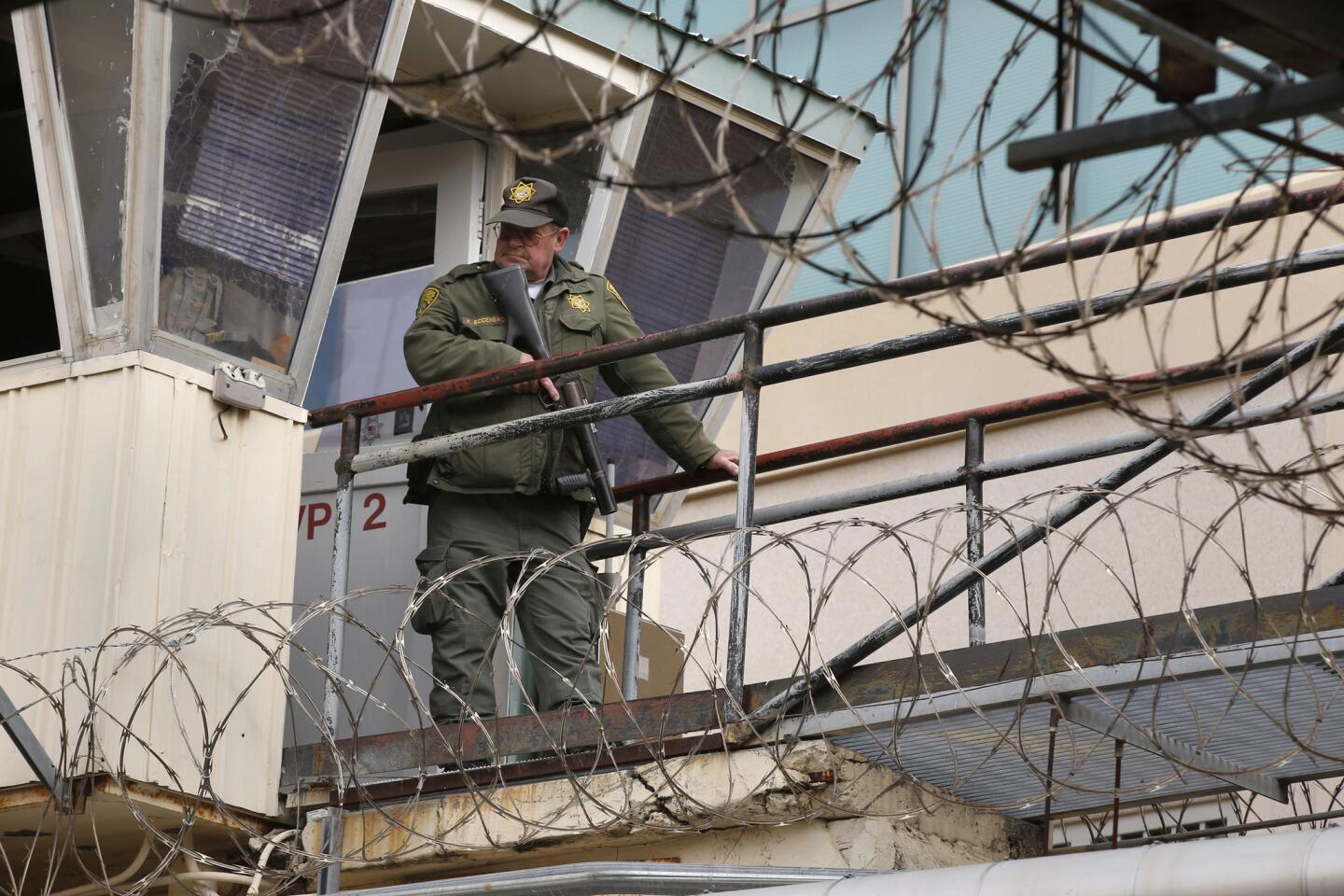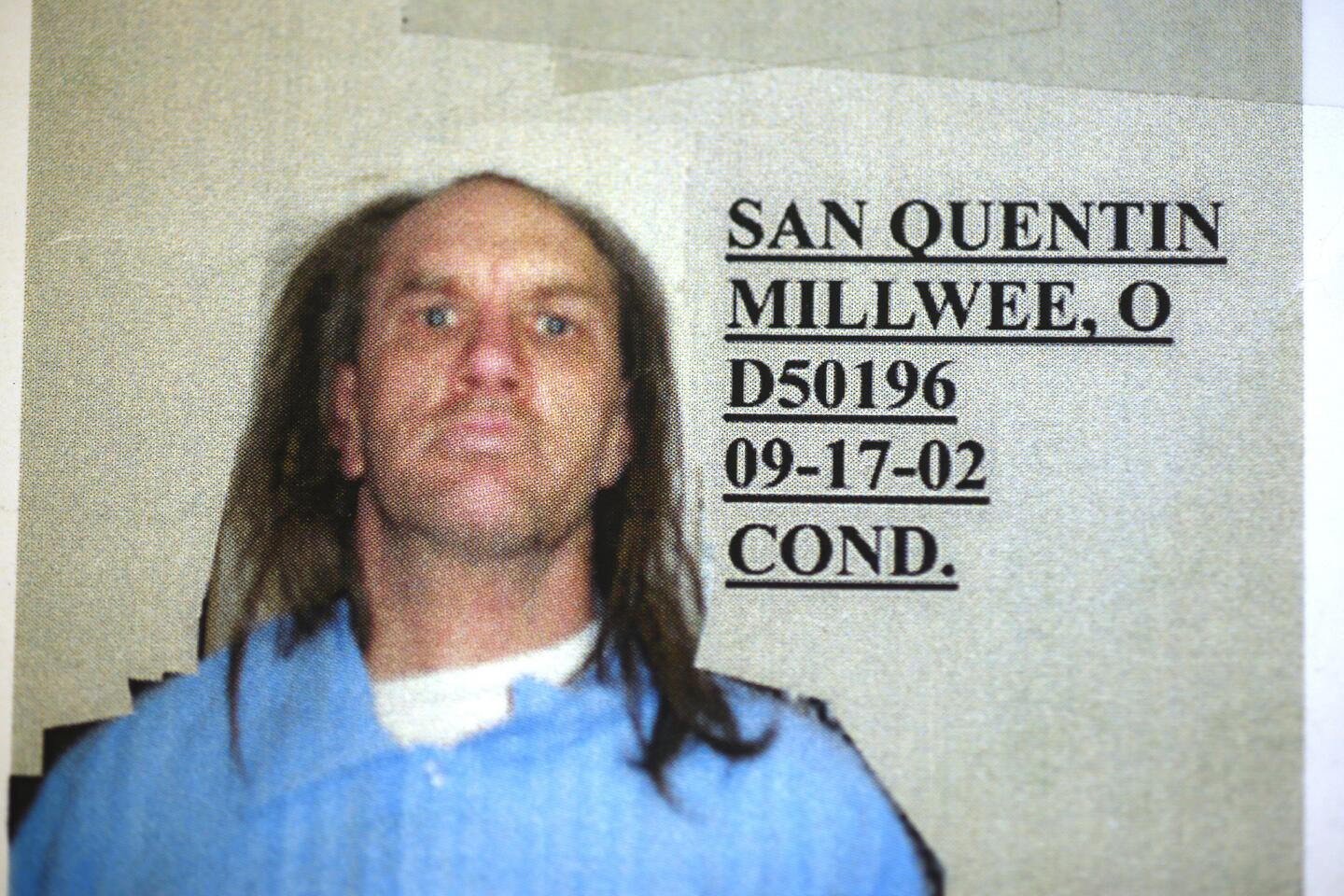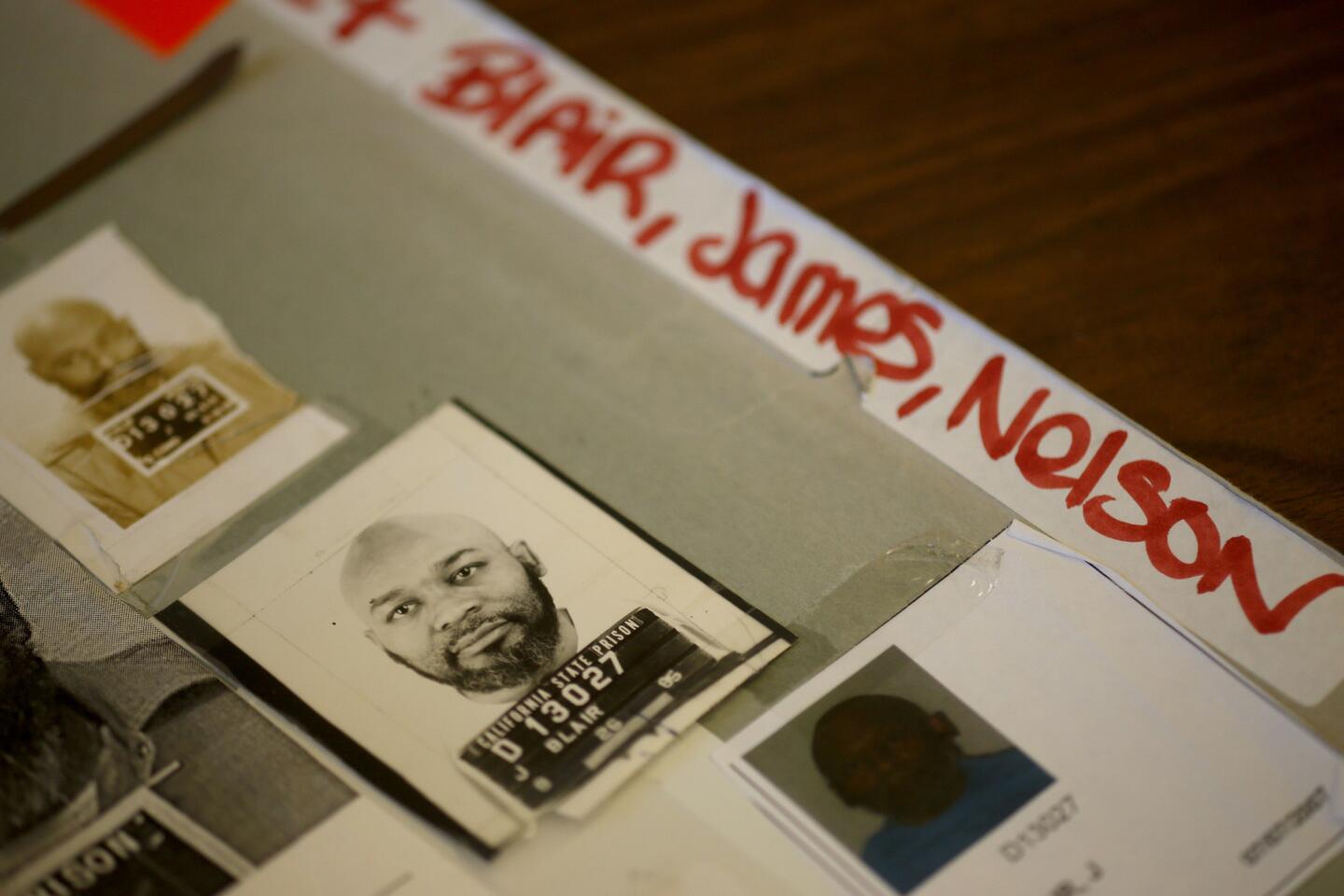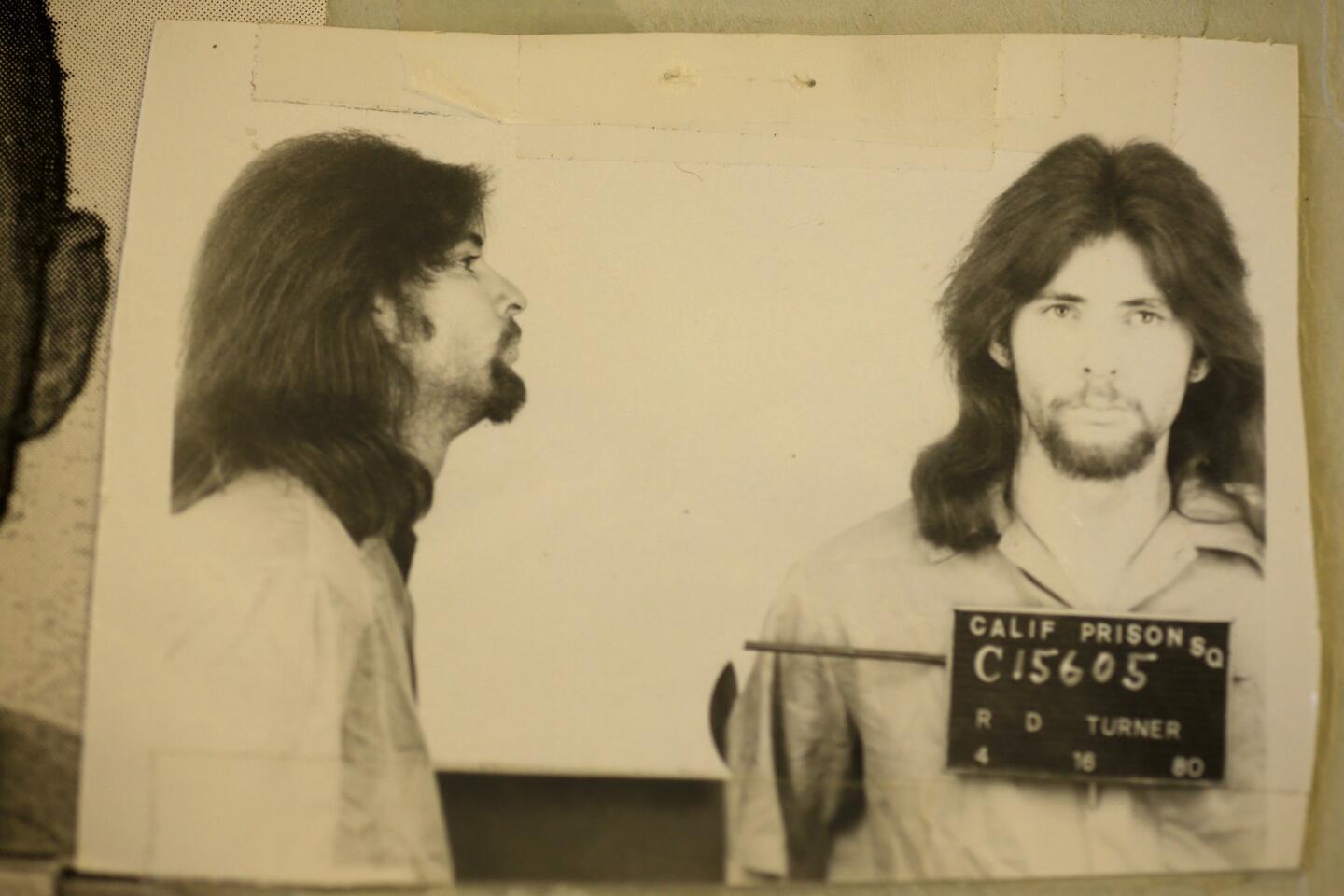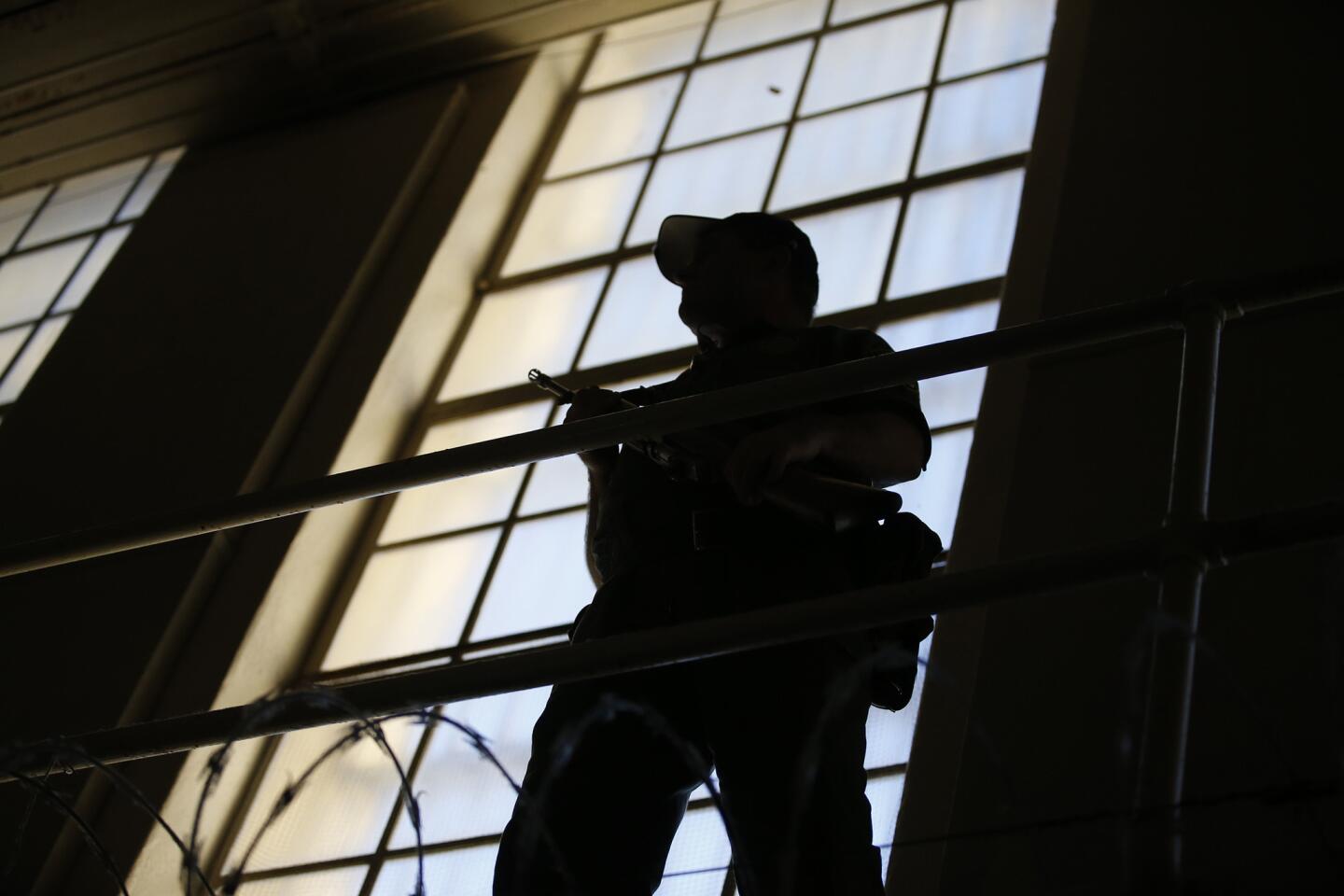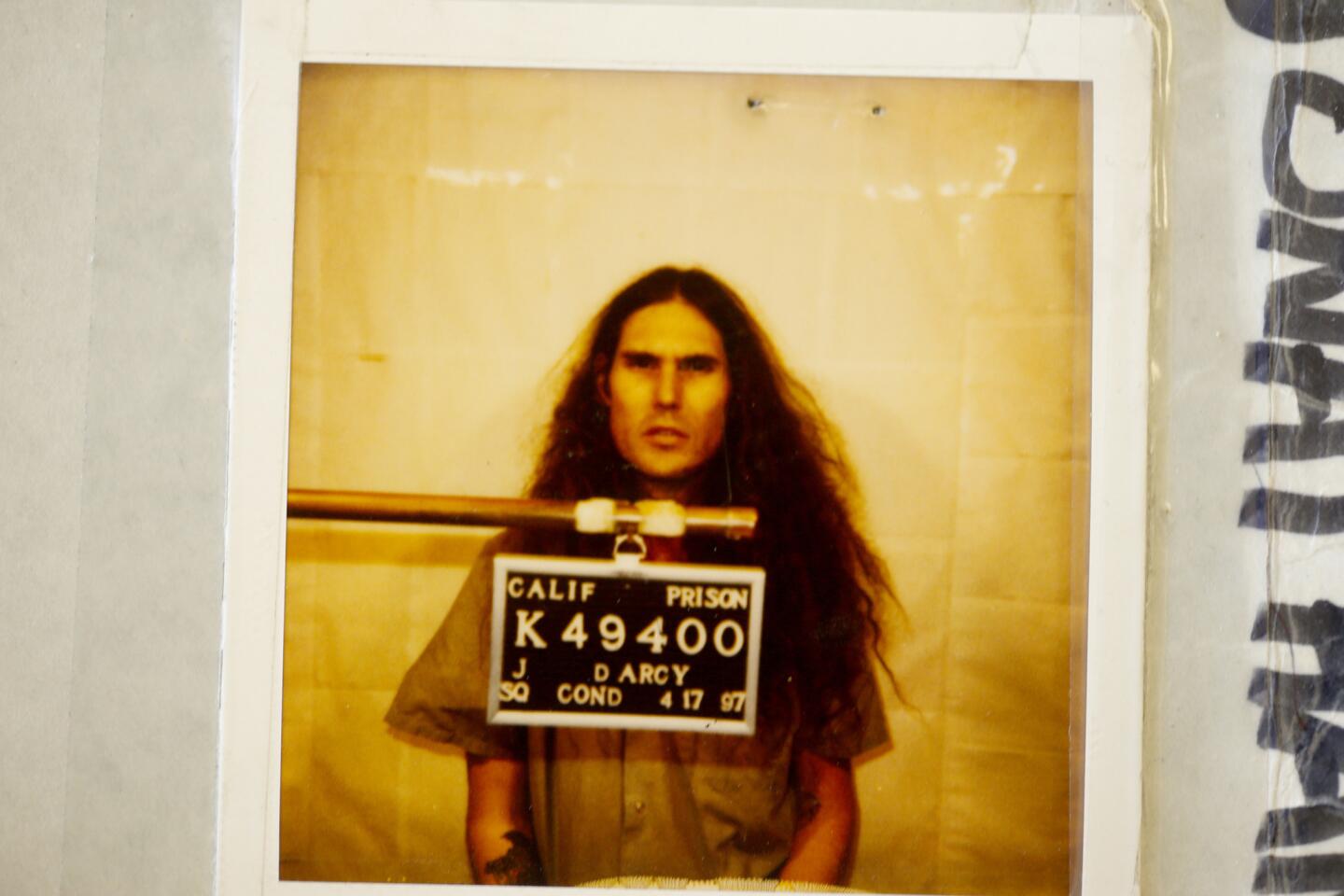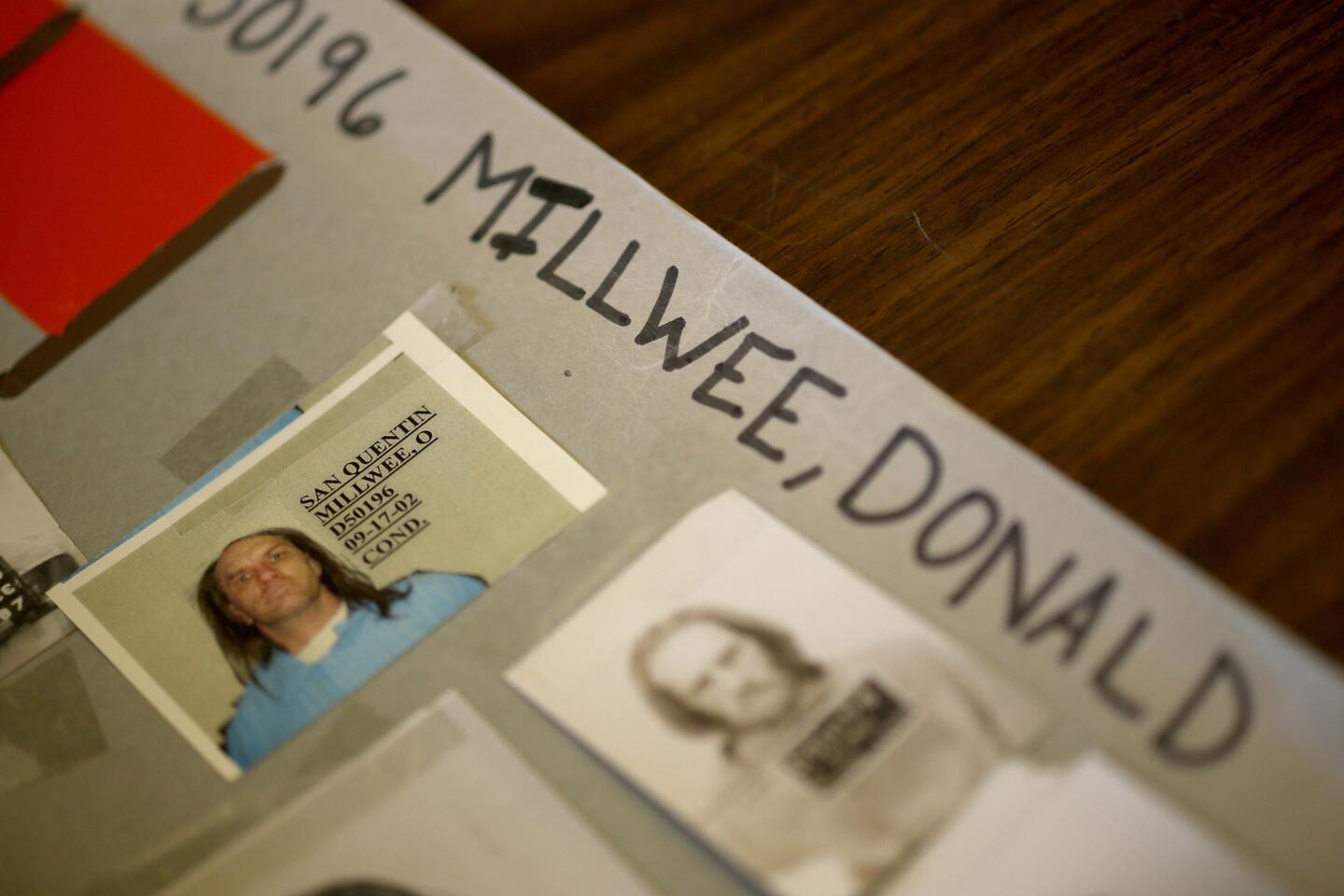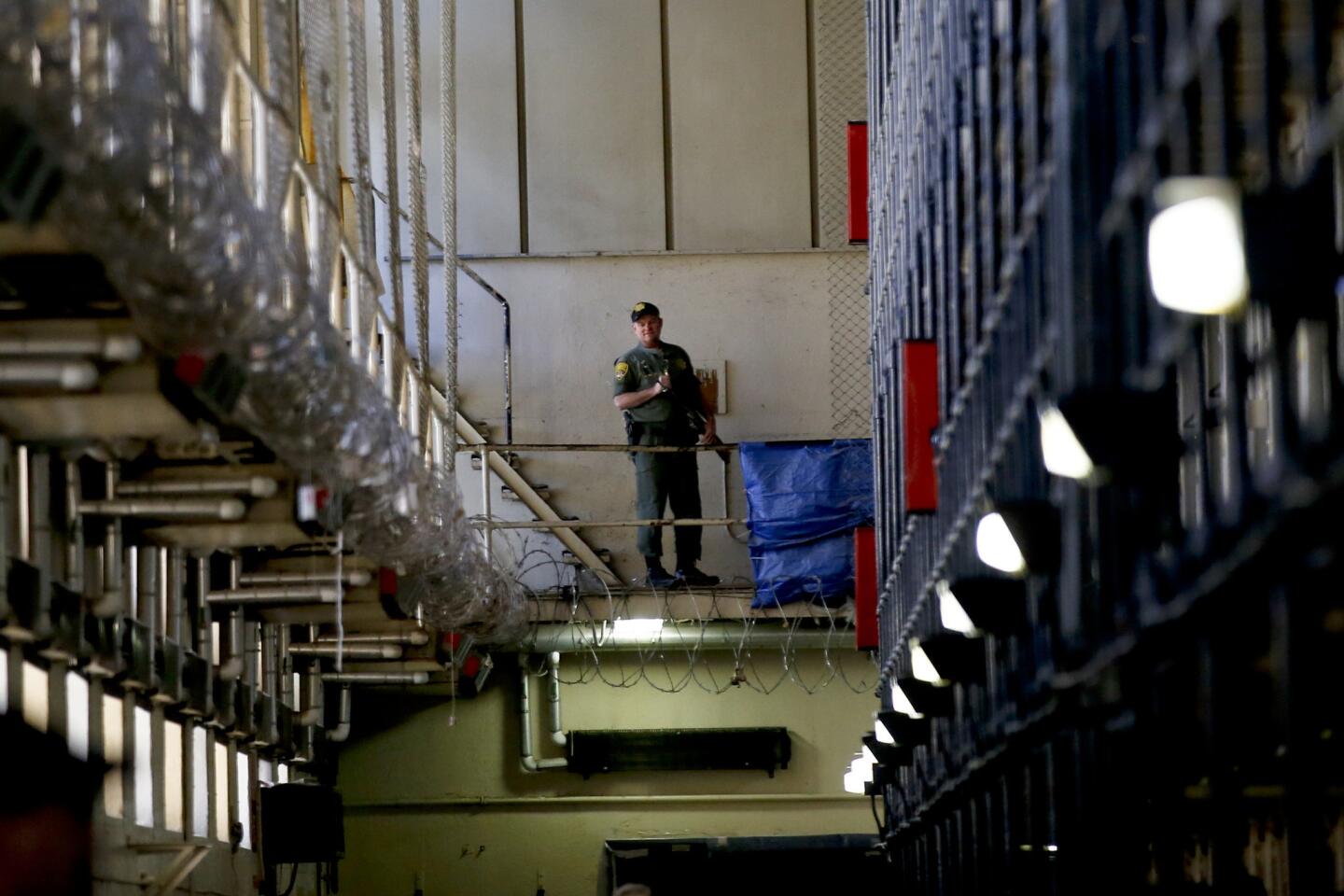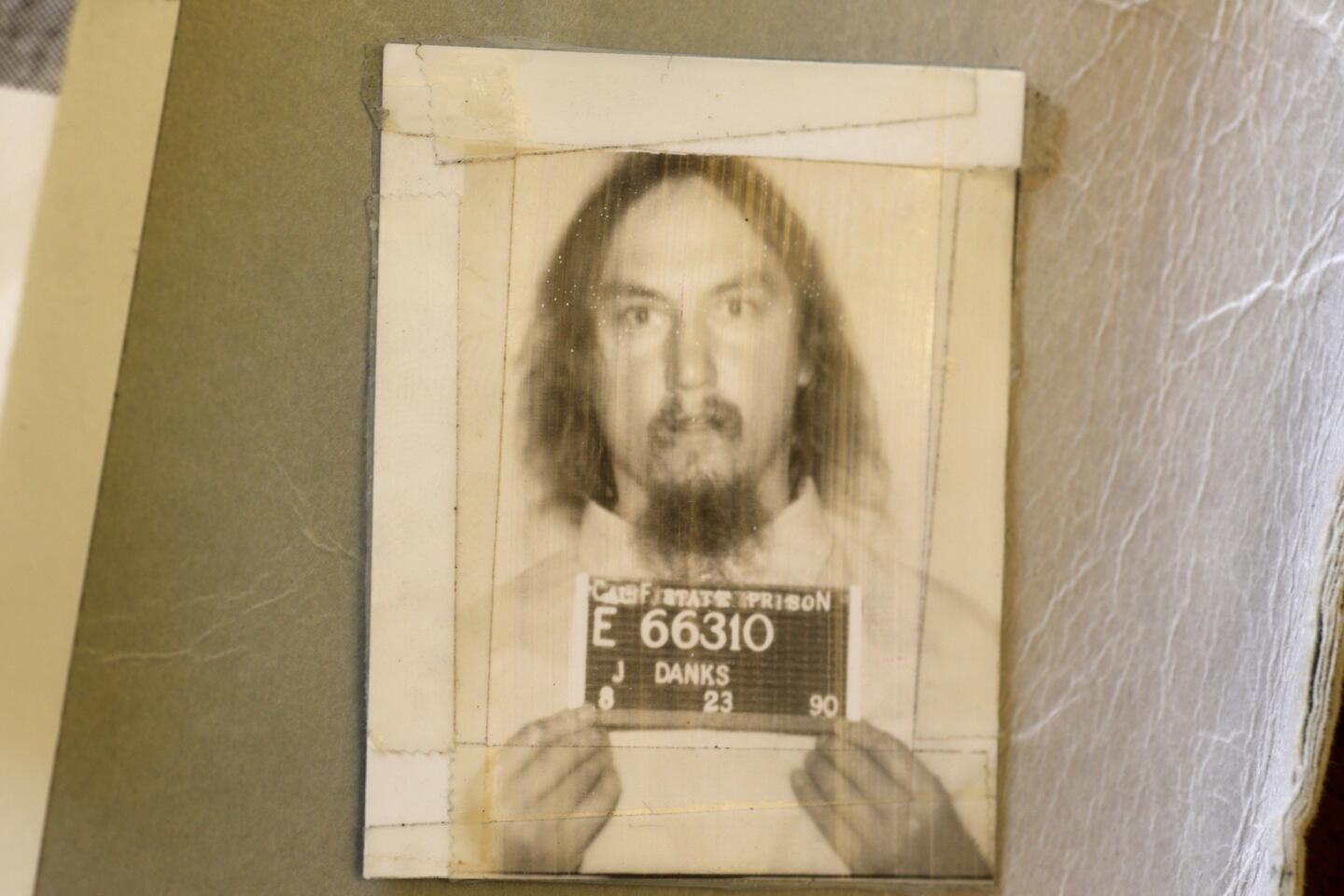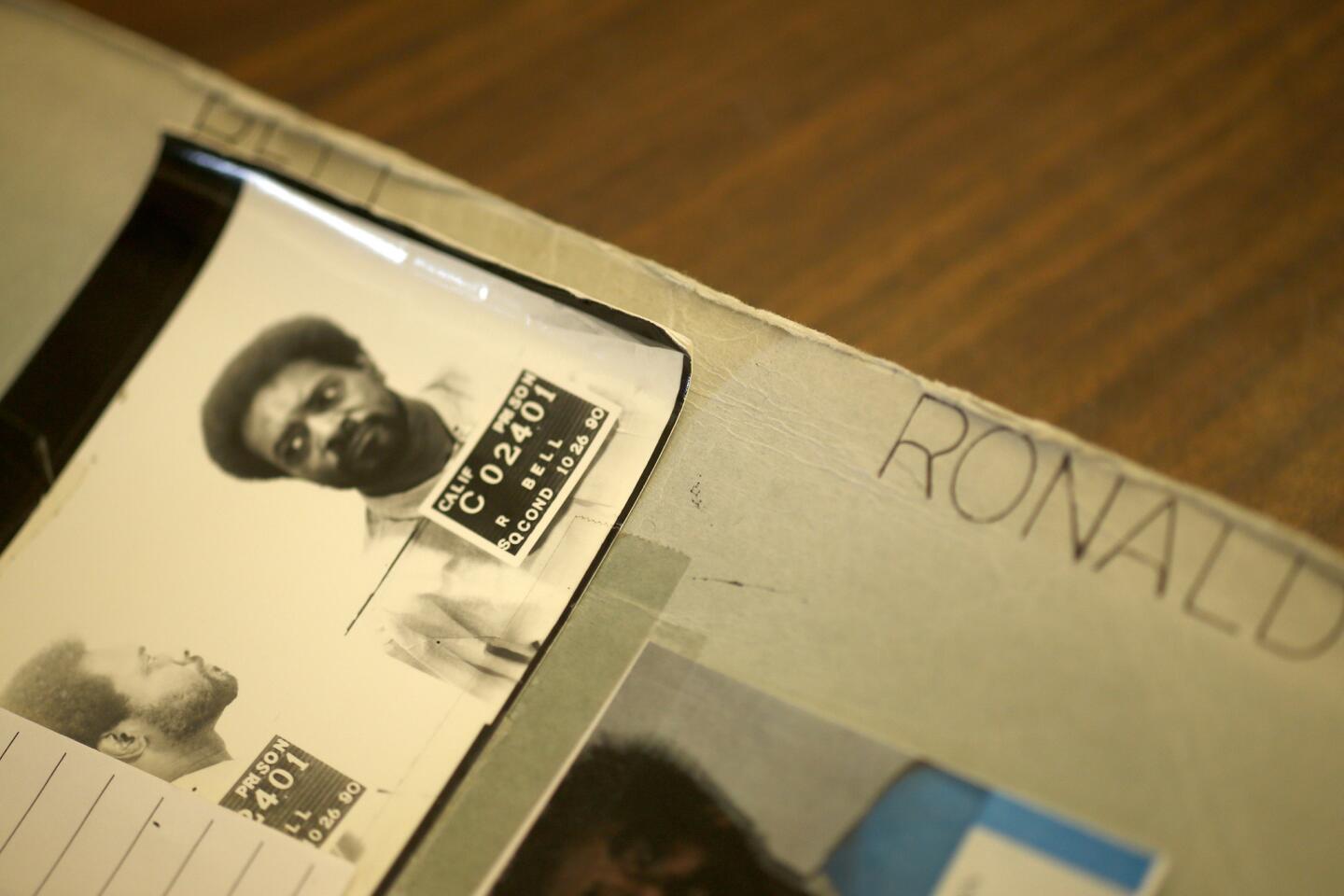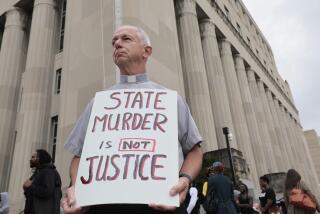On California’s death row, too insane to execute
- Share via
Reporting from San Quentin — On an August afternoon in 1984, Linda Marie Baltazar Pasnick, a 27-year-old aspiring model, was running errands before a fashion competition when she pulled into the drive-through at a Der Wienerschnitzel.
As she waited in line, a panhandler pushed his face into her window and she shooed him away. Ronnie McPeters came back with a gun, leaned in to her open window and fired three times. Then as her car rolled forward and she cried for help, he shot twice more.
McPeters spent the next nine months in the “rubber room” of the Fresno jail. He set fires and assaulted jailers. He told a psychiatrist he was filming a commercial. His bizarre behavior escalated at San Quentin State Prison’s death row, where in months he fell into a stupor, smearing feces on the walls, the floor and himself.
Now, McPeters is at the center of a legal battle with profound implications for California’s death row.
Atty. Gen. Kamala Harris’ office has asked the California Supreme Court to remove Peters from death row, arguing he will always be too gravely disabled to execute. State prosecutors believe McPeters’ sentence should be be converted to life, to be spent in other prisons or state medical facilities.
If the state’s highest court agrees, Harris’ legal theory of “permanent incompetence” would make California the first to address a growing problem of aging and gravely mentally ill inmates awaiting ever-delayed execution.
But the move is also likely spark outrage from families of victims who feel the death sentenced handed down by juries should honored.
Harris’ chief deputy said California has “at least a few other” condemned inmates who like McPeters appear unfit for execution, though he would not cite names.
Federal judges have declared nine men on death row, including McPeters, so incompetent they cannot assist their attorneys. Lawyers for at least 10 more death row inmates have attempted to raise execution sanity claims. Judges, however, have refused to hear those cases, saying it was premature to decide the issue until execution was imminent.
On his worst days on death row, McPeters hoards his feces, rolled for safekeeping, or soaks himself in urine, according to prison psychiatric reports contained in court records. He speaks to a wife and children who did not exist. He says he’s tormented by the inner voices of the relatives of Linda Pasnick.
His care has been inconsistent. At times he was involuntarily medicated for schizophrenia. At another, his psychotropic drugs were stopped. One psychiatrist sent him to be hospitalized and the next had him strapped down five days for observation, then declared him a faker and treated him with vitamin B-12, records show.

Collectively, 20 mentally ill men have spent 539 years on California’s death row. Some say they may be unfit for execution.
In 2007, U.S. District Judge Lawrence O’Neill ruled that McPeters was incompetent to pursue the appeal of his 1986 conviction. Moreover, the judge said, McPeters was likely too insane to execute and the state was wasting money keeping him on death row.
“The public is getting financially raped in this case and this is outrageous,” O’Neill shot back at an April 2013 status conference according to a transcript. “We don’t have one scintilla of evidence ... that he is anything but incompetent.”
Transcripts from court proceedings show then-Atty. Gen. Jerry Brown’s office rebuffed the Oakland judge’s order to craft a settlement aimed at removing McPeters from death row. When Harris took over that office, she continued Brown’s tack.
Then last year, Harris’ office changed course. She joined McPeters’ appeal lawyers in asking the Supreme Court to declare he could never be killed because of his mental condition.
Harris’ solution stunned Victor Pasnick, who had been married to Linda less than two years when she was killed.
“She was just blossoming and all of a sudden she is feeling good and great,” he said, “and then she is murdered.”
He said he didn’t think McPeters’ mental state should play a role in whether he’s executed.
“I can’t say he didn’t deserve it,” Pasnick said. “Knowing what this guy did, making sure she was dead, I think somebody should make sure he is dead. It’s fair play.”
Fresno County prosecutors, who secured the death penalty against McPeters, said they disagree with Harris’ approach. Prosecutors said Harris is opening the door to scores of frivolous challenges in a state where appeals are already bogged down.
“We’re afraid this will become a permanent procedure,” Assistant Dist. Atty. Blake Gunderson said.
Since California restored the death penalty in 1978, jurors in the state have condemned some 900 convicted murderers. Of those, the state has executed 13, and only 16 more have exhausted their appeals.
Currently 747 remain on death row, mostly men housed at San Quentin State Prison. They are as old as 85 and have been there as long as 37 years. Some two dozen require wheelchairs or walkers and at least one is confined to bed in diapers.
Build the beds and they will come. We could probably fill any number of mental health beds.
— State prison executive Elena Tootell, in an internal memo
Complicating matters, executions have been stopped for the last 10 years by legal battles over lethal drug protocols. Opposing ballot initiatives in November ask voters to do away with the death penalty, or to hasten appeals and give the idle condemned something to do with their time, like work.
In the shadow of this debate over the future of the death penalty, officials have just now begun to grapple with how to deal with a subset of the death row population: The gravely insane.
Conditions on death row have long been a subject of debate and legal battles. In the 1980s, the state was ordered to provide basic necessities such as soap and exercise. Ten years ago, the litigation focused on vermin living on East Block that left inmates with rodent bites and encrusted the tier railings in pigeon dung.
A state psychiatrist in one deposition described death row as a “dark, dingy, noisy place” with naked men huddled in the back of their cells, and “psychotic patients yelling, hollering, screaming.”
By 2013, California had the nation’s highest rate of suicide on Death Row. Eleven inmates killed themselves from 2006 to 2013. Prison records show that officials had referred each of them for mental health services.
The issue came to a head that year, when Gov. Jerry Brown filed a motion to end federal oversight of prison psychiatric care statewide. His bid instead opened death row to outside scrutiny for the first time in a decade.
Dr. Pablo Stewart, a nationally acclaimed forensic psychiatrist hired by inmates’ lawyers, said he discovered “a place of terrible failures” with what he called “a high tolerance for psychiatric dysfunction:” unchecked suicides and inmates whose poor condition showed minimal to no psychiatric treatment for decades.
Stewart’s reports on 10 anonymous prisoners persuaded U.S. District Judge Lawrence Karlton to order California to provide full mental healthcare to the condemned.
In late 2014 the state opened the nation’s first death row psychiatric ward.
Less than a year later, 39 of the 40 cells in that ward were occupied and seven other disabled inmates were moved elsewhere. Records obtained by The Times show those recommended for psychiatric hospitalization included inmates untreated for decades, some of whom were delusional and screaming, or afraid to come out of their cells.
They included serial killer Joseph Danks, known as the Koreatown Stalker, and Los Angeles cyanide killer James Blair.
Prison records show involuntary medication orders on death row have tripled, while suicides have plummeted since guards were required to check each condemned inmate every half hour.
“Build the beds and they will come,” state prison executive Elena Tootell wrote in an internal memo. “We could probably fill any number of mental health beds.”
Years of inadequate psychiatric care have taken a toll on death row.
In 2013, a mental health expert hired by the attorney general’s office noted that killer Darren Stanley “was obviously and profoundly psychotic,” and had gone “undiagnosed and untreated for years” at San Quentin, even after a chance CT scan revealed the front lobes of his brain were degenerating.
An independent psychiatrist chosen by a federal judge in 2014 found that Oscar Gates, who gunned down two Oakland crime partners and contends the state seeks to steal his inheritance from Howard Hughes, remains not only incompetent to assist in his appeals, but after 26 years without treatment and “the long duration of his mental illness,” is likely beyond restoration.
The U.S. Supreme Court in 1986 ruled that execution of the insane was cruel, but left the test for sanity to the states.
Under California law, the competency of an inmate is not reviewed until weeks before an execution. If the warden then questions an inmate’s sanity, a sanity trial is conducted. That has happened only twice in California, the last time in 1998, when the state sought to execute Horace Kelly for rape and murder.
Kelly lived in a trash- and feces-filled cell so foul guards put on masks if they had to enter to hose it down. Five of six experts concluded Kelly was incompetent. But a Marin County jury found Kelly “aware” of his sentence and the reason for it and voted for execution, 9-3. A stay by a federal judge stalled the execution, and Kelly’s lawyers have since raised new grounds for appeal.
Notes from a prison meeting in the case show San Quentin staff debated whether forcing Kelly to take medications would make him “healthy enough for us to execute him.”
The California Supreme Court has rejected other such motions put before it as “premature,” because execution was not imminent and the inmate’s mental state might change.
But over the last few years, at least three federal judges have pressed the state attorney general’s office to remove the most insane inmates from death row -- including the judge hearing McPeters’ appeal.
State lawyers have said they can only take such action if there has been a “miscarriage of justice.”
That stance changed last year when Harris struck a deal with the Habeas Corpus Resource Center, a state-funded legal center created to train death row appeal attorneys. After nearly three decades, McPeters’ death penalty appeal had made it to federal court but stalled over the question of whether he was sane enough to assist lawyers. Harris’ office agreed that if the center would file a new appeal with the California Supreme Court contending McPeters is permanently insane, Harris would tell the court she has no reason to disagree and ask that his death sentence be dropped.
“You cannot execute someone who is incompetent. There is no dispute about that,” said Nathan Barankin, Harris’ chief deputy. He said his office now believes some condemned inmates are so “grievously incompetent” there is no need to wait for an execution date to declare them insane.
Although local prosecutors have no official role in the settlement, Barankin said, the state Supreme Court could send McPeters’ case back to Fresno County for resentencing.
In the end, Barankin said, the attorney general’s office was unsure what happens to McPeters after “the death penalty is taken off the table.”
“We’re making this up as we go along,” he said. “It is a new process and procedure.”
Michael Rushford, director of the conservative Criminal Legal Justice Foundation, which sued the state to force renewal of executions, said incompetent inmates should be removed from death row. But he and others voiced concern over who would be eligible. At the same time, defense lawyers opposed leaving the decision to the attorney general.
Deciding who should be spared the death penalty could be a wrenching process complicated, experts say, by the likely public outrage over declaring notorious criminals too insane to be executed.
Jeffrey Jones is one of those difficult cases. In 1985, he prowled public restrooms around Sacramento with a claw hammer to bash the heads of strangers, killing three.
During his three decades on death row, Jones has cascaded between mute catatonia and rabid mania, declaring he was the decapitated governor of California. For the last three years, psychiatric and court files show, he has been barely able to grunt.
His federal defenders have filed a new state appeal in the 31-year-old murder case, contending Jones mental condition makes it cruel for the state to condemn him to death.
ALSO
A revealing look at California’s death row
More than 4% of death row inmates wrongly convicted, study says
Tapes show inmates forced from cells by guards using pepper spray
More to Read
Sign up for Essential California
The most important California stories and recommendations in your inbox every morning.
You may occasionally receive promotional content from the Los Angeles Times.
